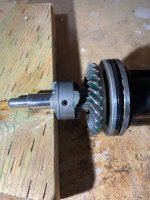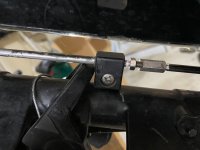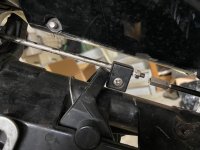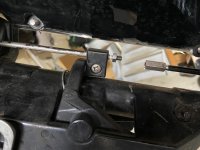I am in the process of replacing the clutch on my 9.9 HP Mercury Outboard (SN OR126144). The motor will not shift into reverse, but works fine when shifting from forward to neutral and back to forward. The reverse clutch dogs are rounded off, so engagement is very difficult. See the first picture. You can see the worn reverse dogs on the clutch.
The shifting linkage seems to be correct, but when I look at the shifting cam in the gear housing when the motor is in neutral, the cam is positioned on the ramp between reverse and neutral "steps" on the shifting cam. In looking at the linkage, I think I know why, but would like some feedback from the forum.
I have attached three more pictures. Picture one shows the linkage when the engine is in reverse. Picture two is when the engine is neutral, and picture three is when the engine is in forward gear. The lower linkage is disconnected in all three situations. I am trying to figure out if the position of the reverse lock (the black block attached the the upper shift linkage) is correct. The purpose of the reverse lock is to release the reverse lock hook. This hook locks the engine in neutral and reverse and releases the engine when it is in forward gear. By releasing, I mean the engine will swing up when in forward should one have the misfortune of hitting something under water and I guess it's to minimize damage to the Lower Unit and prop.
When in reverse, you can see the reverse lock is touching the reverse lock hook, however the hook is actually applying some downward force on the shift linkage through the lock because the hook is spring loaded. This extra downward force seems to prevent the the shift linkage from moving up an additional 1/4". As a result, the shift cam in the lower unit ends up being positioned on the ramp between the reverse gear step and the neutral step. When you shift into forward gear, the reverse lock releases the reverse lock hook, as it should. I am wondering if the reverse lock should be moved about 1/4" down on the shift linkage so the shift cam ends up in the correct spot when in neutral. As long as the reverse lock hook is released when in forward gear, it should be ok, unless there is some secondary function it performs that I am not aware of. I cannot find any procedure in the service manuals on the positioning and setup of the reverse lock.
Any thoughts on the positioning of the reverse lock on the shifting shafts? Thanks,
Doug
The shifting linkage seems to be correct, but when I look at the shifting cam in the gear housing when the motor is in neutral, the cam is positioned on the ramp between reverse and neutral "steps" on the shifting cam. In looking at the linkage, I think I know why, but would like some feedback from the forum.
I have attached three more pictures. Picture one shows the linkage when the engine is in reverse. Picture two is when the engine is neutral, and picture three is when the engine is in forward gear. The lower linkage is disconnected in all three situations. I am trying to figure out if the position of the reverse lock (the black block attached the the upper shift linkage) is correct. The purpose of the reverse lock is to release the reverse lock hook. This hook locks the engine in neutral and reverse and releases the engine when it is in forward gear. By releasing, I mean the engine will swing up when in forward should one have the misfortune of hitting something under water and I guess it's to minimize damage to the Lower Unit and prop.
When in reverse, you can see the reverse lock is touching the reverse lock hook, however the hook is actually applying some downward force on the shift linkage through the lock because the hook is spring loaded. This extra downward force seems to prevent the the shift linkage from moving up an additional 1/4". As a result, the shift cam in the lower unit ends up being positioned on the ramp between the reverse gear step and the neutral step. When you shift into forward gear, the reverse lock releases the reverse lock hook, as it should. I am wondering if the reverse lock should be moved about 1/4" down on the shift linkage so the shift cam ends up in the correct spot when in neutral. As long as the reverse lock hook is released when in forward gear, it should be ok, unless there is some secondary function it performs that I am not aware of. I cannot find any procedure in the service manuals on the positioning and setup of the reverse lock.
Any thoughts on the positioning of the reverse lock on the shifting shafts? Thanks,
Doug























